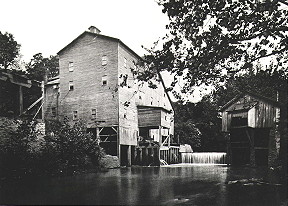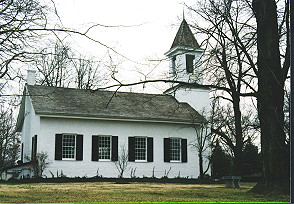 Nathaniel Shepard Armstrong, his wife Hannah, and their children drove their wagons across the roots and ruts of wilderness traces enroute to this area, sometimes waiting out flooded rivers in order to pass. Reaching the Ohio River, they built flatboats to float themselves, their livestock, and all their worldly goods down the broad Ohio to where the Little Miami joined it at Columbia landing.
Nathaniel Shepard Armstrong, his wife Hannah, and their children drove their wagons across the roots and ruts of wilderness traces enroute to this area, sometimes waiting out flooded rivers in order to pass. Reaching the Ohio River, they built flatboats to float themselves, their livestock, and all their worldly goods down the broad Ohio to where the Little Miami joined it at Columbia landing.
In 1800, after weeks of hazardous and exhausting travel from their home in Virginia, they constructed a log cabin on what is now called Indian Hill, above the current Wooster Pike, overlooking the Little Miami River. They were able to bring with them only a few of their possessions from their Virginia home, but they were hardy folk of vision, ambition, and courage who were strong in their faith in God. Among the treasures brought to their new home was the brass-bound family Bible, now in the possession of Armstrong Chapel Church. It was the family’s source of strength, hope, and faith; and the Armstrongs, along with their children, labored from dawn to dusk on the fertile land to make a new life.
Nathaniel Armstrong had been a miller in Virginia, so it was quite natural that a mill was built on the Armstrong land in 1802, said to be the second mill in the Miami Valley. Shortly afterwards, two other mills were built and run successfully by their industrious sons. Despite early difficulties they developed a successful business and a dependable living. The Armstrong sons also later built mills of their own, not only to grind grain but also to pull and card fiber with the primitive machinery then in existence.
Born near Baltimore, Maryland, in 1749, Nathaniel Armstrong lived there for 36 years, and then settled in Virginia’s Shenandoah Valley in 1785, in Rockingham County. He acquired “200 or 300 acres of government land” and worked a farm there for the next 15 years. He and Hannah had six sons (William, John, Thomas, Leonard, Nathaniel, Jr., and James) and three daughters (Elizabeth, Alice, and Priscilla.) Son Leonard’s “brief autobiography” (1871) written in his 93rd year, tells us what we know of the Armstrongs. He wrote that his older brother, John, helped President Washington suppress the Whiskey Rebellion in Western Pennsylvania in 1795. Also, it was John who originally urged his family to follow him to his mill site on the Little Miami River near what is now Newtown. His father Nathaniel sold his Virginia farm for “twelve or fifteen dollars” an acre and set out for Greenbrier (now West Virginia,) where his daughter Elizabeth, already married to Francis Settles, lived in the mountains. After a stay of a few days, Leonard Armstrong recalled the family continued on their six weeks’ journey to Ohio country. He relates that at one point they found the Gauley River so high they could not cross it for several days. Having depleted their supply of flour or meal, they were obliged to buy corn at $1.00 per bushel, pounding it in a mortar for something to eat.
After a few years in Ohio, Nathaniel Armstrong was able to purchase over 300 acres of choice land extending from Wooster Pike to today’s Indian Hill Road. There, in 1820, he built a comfortable frame house, enlarging it as he succeeded as a farmer, mill owner, and a man of property.
 In the early days of Indian Hill settlement, families met together on the Sabbath to worship in homes or in barns. As the population of the area increased, there was a need for a church as a permanent place of worship. Aware of this, Nathanial Armstrong deeded the choice corner of his property (now Drake and Indian Hill Roads) for a church site and burial ground on June 18, 1830. Called Armstrong Chapel in his honor, the property was not given to a specific congregation or religion, but to whichever denomination had the largest number of adherents on Indian Hill. Thus, historically, it has been served by Methodist ministers.
In the early days of Indian Hill settlement, families met together on the Sabbath to worship in homes or in barns. As the population of the area increased, there was a need for a church as a permanent place of worship. Aware of this, Nathanial Armstrong deeded the choice corner of his property (now Drake and Indian Hill Roads) for a church site and burial ground on June 18, 1830. Called Armstrong Chapel in his honor, the property was not given to a specific congregation or religion, but to whichever denomination had the largest number of adherents on Indian Hill. Thus, historically, it has been served by Methodist ministers.
In the autumn of 1831 the first service was held in Armstrong Chapel, with the first preachers being circuit riders of the Methodist Church, to be followed later by resident ministers. The cemetery predates the chapel, with the first person buried there being Hannah Armstrong, who had died in 1827 at the age of 84 and was interred on the Armstrong farm. Thirteen years after her death, the founder of the cemetery and church joined her in the burying ground. The eroded stone marking his grave bears this legend:
SACRED
to the memory of
Nathaniel S. Armstrong
Who departed this life
July 4th, 1840
Aged 91 years.
